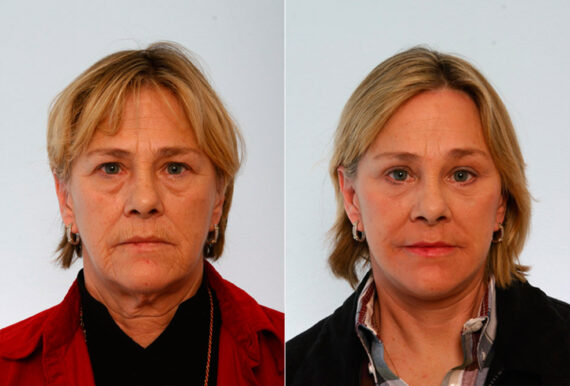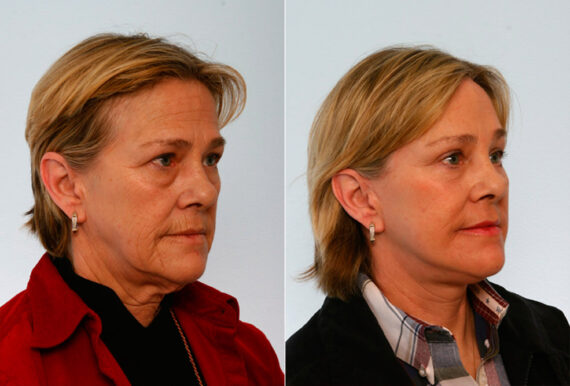An endoscopic brow lift, also known as a forehead lift, aims to rejuvenate the upper eyelids and forehead region. This procedure is less invasive compared to traditional methods like a coronal brow lift or hairline brow lift, involving minimal incisions typically hidden within the hairline.
Dr. Paul Vitenas shares insights into this procedure, highlighting its advantages such as addressing droopy eyebrow issues, reducing forehead wrinkles, and potentially minimizing hair loss. The endoscopic method significantly reduces the visibility of scars compared to more invasive techniques, and the recovery time is considerably shorter, making it a popular choice at surgical centers specializing in eyelid surgery for men and women, and forehead rejuvenation.

Expectations from an Endoscopic Brow Lift
- An endoscopic brow lift is a minimally invasive procedure aimed at enhancing forehead and eyebrow appearance.
- Patients should anticipate temporary swelling and bruising post-surgery, which typically resolves within two weeks.
- Recovery after an endoscopic brow lift usually involves following specific aftercare instructions and avoiding strenuous activities.
- Visible improvements from the procedure are generally noticeable once the initial swelling subsides, with final results apparent after a few months.
- Choosing a qualified plastic surgeon is crucial for ensuring safety and achieving desired cosmetic outcomes from an endoscopic brow lift.
What to Expect When Considering an Endoscopic Brow Lift
Comparing Endoscopic and Traditional Techniques
An endoscopic brow lift updates the coronal brow lift, direct brow lift, and hairline brow lift with advanced technology. Here’s how the endoscopic method contrasts with other methods:
- Less Invasive
- Shorter recovery time
- No visible scars
The endoscopic brow lift stands out among various types of brow lifts due to its effectiveness and minimal recovery time. Its precision and the subtle improvements it offers make the endoscopic brow lift technique favorable for a refreshed appearance. In contrast, traditional brow lifts, which include the coronal, direct, and hairline methods, may be more invasive with longer recovery periods. The type of brow lift chosen should align with the desired outcome, considering both aesthetic goals and recovery implications.
Benefits of an Endoscopic Brow Lift
An Endoscopic Brow Lift typically results in a shorter recovery period than traditional methods. This approach uses smaller incisions, which can lead to a swifter healing process, often allowing for a quicker return to daily activities.
Advantages of this procedure include:
- A raised brow position for a more alert look.
- Diminished forehead lines, contributing to facial balance.
- Lessened bruising and swelling from the minimally invasive technique.
This brow enhancement procedure targets the brow depressor muscles, making it ideal for addressing conditions like brow ptosis, creased brows, and uneven brows.
Who would be an ideal candidate for an endoscopic brow lift?
Health Considerations
Individuals considering an endoscopic brow lift should have good health with a fully reviewed medical history demonstrating no risks for surgery or recovery. Candidates must be non-smokers and have practical expectations concerning the surgery’s results.
Aesthetic Goals
Those looking to smooth forehead lines and raise a drooping brow to counter a worn-out or upset look may find this procedure fitting. The endoscopic brow lift suits potential candidates seeking minimal scarring and noticeable yet subtle rejuvenation.
Ideal candidate qualities include:
- Good overall health
- Non-smokers
- Practical outcomes in mind
- Seeking minimal scarring
Endoscopic brow lift candidates often share individual goals focused on attaining a more vibrant appearance.
What to Expect When Preparing for Your Endoscopic Brow Lift Surgery
Initial Consultation
Before an endoscopic brow lift surgery, you will have an initial consultation to discuss your cosmetic aspirations and ensure the procedure is right for you. The consultation will cover your health history and medications, focusing on transparency for a safe surgical outcome.
Pre-operative Instructions
As your endoscopic brow lift appointment approaches, adhere to these pre-operative instructions to prepare your body and aid recovery:
- Stop medications that may increase bleeding risk
- Comply with eating and drinking guidelines before surgery
- Arrange transportation for after the procedure
Following these steps is crucial for a successful endoscopic brow lift surgery.

Understanding the Endoscopic Brow Lift Procedure
Anesthesia and Incision
Anesthesia is used for patient comfort during the endoscopic brow lift procedure. A surgeon makes small incisions in the hairline that give access to the endoscope and instruments. Paramedian incisions are also made for precise adjustments. A camera on the endoscope helps the surgeon work with minimal tissue disruption.
Closing the Surgical Incisions
After adjusting the forehead tissue, the surgeon carefully closes each incision. This reduces visible scarring. Small stitches or staples are used for closure. While post-operative care affects scarring, the initial closure is crucial for healing.
Incision and closure are vital steps in the endoscopic brow lift procedure, with both paramedian incisions and the careful closing of surgical incisions playing key roles in patient outcomes.
Recovery Expectations After an Endoscopic Brow Lift
Immediate Post-operative Care
It is important to follow careful recovery instructions during the initial recovery phase. Swelling and bruising may occur, but they will decrease over time.
Healing Timeline
The healing timeline greatly depends on the individual, yet typically, improvements are seen within weeks. It’s important to continue regular check-ups to monitor the healing process.
Managing Discomfort
Effective methods to manage discomfort include:
- Elevating your head while resting.
- Using cold compresses for swelling.
- Following pain management advice.
- Avoiding heavy activities that may increase swelling or lead to bleeding.
Contact your surgeon if swelling continues or pain increases unexpectedly.
The Risks and Complications of Endoscopic Brow Lift Surgery
Endoscopic brow lift surgery is less invasive yet comes with its own set of risks and complications. It’s essential to know these before proceeding with the surgery. Scarring is usually minimal with this technique, but everyone heals differently, and more noticeable scarring can occur.
The procedure requires careful work around nerves, such as the facial nerve. There is a small chance of nerve issues like cranial nerve V1 hypoesthesia, which reduces forehead sensation. Facial nerve damage could lead to asymmetry or challenges with facial movements. Surgeons aim to avoid these issues through precision.
If complications occur, they may need further medical treatment or follow-up procedures. Discuss these risks with your surgeon to make a knowledgeable decision.
- Minimal scarring: small incisions lead to less scarring, though individual healing varies.
- Nerves: risk of affecting nerves, including facial nerve and cranial nerve V1 hypoesthesia.
- Facial nerve damage: could result in asymmetrical appearance or expressive difficulties.
Expectations for Long-term Outcomes and Maintenance
An eyebrow lift can enhance brow appearance for many years. Individual factors like skin type and age influence long-term outcomes. These effects combat the natural aging process.
Tips for Maintaining Results
For optimal maintenance of your eyebrow lift:
- Use sunscreen daily to protect your skin.
- Follow a skincare routine for skin elasticity.
- Keep a stable weight.
- Regularly visit your surgeon to check on the eyebrow results.
Choosing the Right Surgeon for Your Endoscopic Brow Lift
Qualifications to Look For
Selecting the right surgeon influences the safety and quality of your endoscopic brow lift. Verify these qualifications:
- Board Certification: Look for a board-certified oculofacial plastic surgeon to guarantee specialized facial procedure training.
- Experience: The surgeon should have a history of successful endoscopic brow lifts.
- Specialization: A facial plastic surgeon has detailed knowledge of facial anatomy, which is beneficial.
Essential Questions for Your Consultation
During your consultation, ask questions to build confidence in your surgeon choice:
- Procedure: What brow lift technique will be used?
- Past Results: Can I see before and after photos?
- Recovery: What does the recovery involve?
- Handling Complications: How are complications managed?
Choosing a qualified plastic surgeon and discussing key points during your consultation is critical.
If you’re considering an endoscopic brow lift and want expert advice, scheduling a consultation with Dr. Paul Vitenas is a wise choice. With his extensive experience as a board-certified plastic surgeon, Dr. Vitenas is known for his commitment to achieving balanced, beautiful results, and his practice is recognized as one of the leading medical aesthetic centers in the country.
Having received numerous accolades for his dedication to patient satisfaction, including the Best Facial Plastic Surgeon in Houston for 2022, Dr. Vitenas offers personalized care and detailed treatment plans. Contact us at Vitenas Cosmetic Surgery to discuss how Dr. Vitenas can help you achieve your aesthetic goals.


